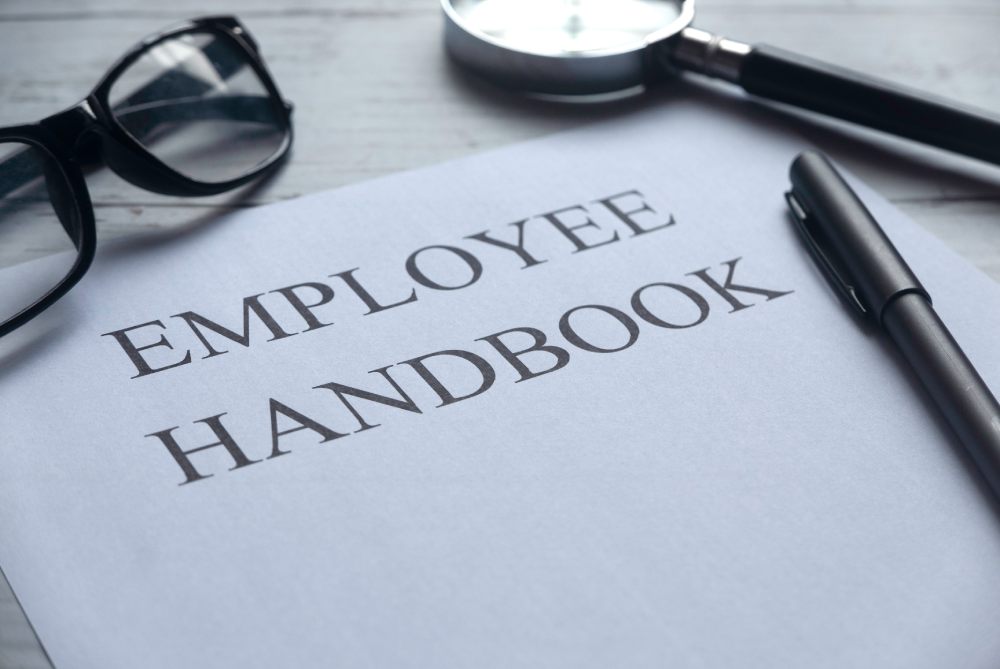by Strategic HR Partners
Share
by Strategic HR Partners

Make sure your employee handbook is up to date with the latest HR hot topics; learn more about what to include here!
1. Collective Bargaining
In a series of cases in recent years, the National Labor Relations Board (NLRB) has made it clear that companies must protect their employees’ free speech rights.
Tips for an Effective Handbook
- Be concise. But don’t be too legalistic in wording.
- Be original. Don’t borrow language from other organizations.
- Be careful. Have legal counsel review it at least annually.
Many companies are concerned—rightfully so—about workers disclosing confidential business information, so they have created rules that attempt to restrict what employees can say to colleagues and people outside the organization. Handbooks can prohibit employees from revealing confidential business information, such as data on vendors and customers, but the text should avoid any language that could be interpreted as infringing on speech and actions that the NLRA protects.
2. Social Media and Data Privacy
Many people today perform work-related tasks on personal smartphones and tablets. They conduct personal business and participate in social media on these devices as well. Handbooks must make it clear that employees have no right of privacy while accessing social media at work or on company-owned equipment.
Handbooks should state that workers cannot disclose proprietary information—with the exception of speech protected by the NLRA. Finally, it should state that, when a person leaves the organization, his or her devices can be wiped clean of the employer’s data.
3. Reasonable Accommodations
Employees are entitled to reasonable accommodations under certain circumstances, such as for physical and mental health conditions; for religious beliefs, practices and observances; and for pregnancy, childbirth and related medical issues.
Employers should spell out in their handbooks not only the legal bases for accommodations but also the company’s intention to comply with them when reasonable. Managers must be put on notice that, if a worker mentions a condition that might qualify, they should ask if the employee is seeking an accommodation.
4. Retaliation
Many handbooks say the organization will not tolerate retaliation, which in recent years has been the most common charge brought by the U.S. Equal Employment Opportunity Commission. But not all such passages state that they protect witnesses and others who participate in an investigation of a retaliation claim.
In addition, the handbook should state that the employer cannot promise confidentiality for people who make retaliation complaints. The process must be fair for both the person making the retaliation claim and the individual who is being accused.
5. Wages and Payroll
Two pay-related issues—unauthorized overtime and improper deductions from workers’ pay—frequently trip up employers and should be addressed in writing to minimize legal liability. With respect to the first issue, employers are watching to see what happens with the proposed changes to the federal overtime regulations, although it is too early to know what handbook revisions will be necessary as a result.
It’s not uncommon for people to work more hours in a pay period than planned. Federal law makes it clear that, if employees qualify for overtime, they must be paid for the additional work they do outside their normal hours. However, companies should state in their handbooks that employees may not work overtime without advance permission from their manager and that managers can discipline employees after they work unapproved overtime. States have passed several significant employment laws in recent years, and municipalities are joining the trend. Every employer is responsible for staying abreast of changes to laws and regulations that impact its worksites, and then adjusting policies and practices accordingly. Employee handbooks cannot be amended every time a new law or rule takes effect, of course, but at least once a year they should be updated to reflect the most recent and important changes.
6. State-Specific Laws
States have passed several significant employment laws in recent years, and municipalities are joining the trend. Every employer is responsible for staying abreast of changes to laws and regulations that impact its worksites, and then adjusting policies and practices accordingly. Employee handbooks cannot be amended every time a new law or rule takes effect, of course, but at least once a year they should be updated to reflect the most recent and important changes.
7. Leave Benefits
Options for Multistate Employers
- A single handbook. Include all state and local variations in topical sections.
- Multiple versions. Tailor each handbook version to each company location.
- A back-end approach. Deal with state-specific issues in addenda.
Such provisions can promote workers’ well-being and boost employee morale, as well as enhance the image and brand of the organization.
8. Attendance
Employers must be careful how they treat a worker who is not eligible for leave under the federal Family and Medical Leave Act (FMLA) or who has exhausted such leave. He or she might still be eligible for leave under the Americans with Disabilities Act (ADA). Your handbook should note that a person might qualify for leave under the ADA as a reasonable accommodation.
Employers are urged to perform a thorough individual assessment of each person who takes federally protected leave, and that practice should be emphasized in writing. Make it clear that workers will not be punished for legitimate absences from work.
9. Smoking and Marijuana Use
Handbooks that do not mention e-cigarettes specifically should be revised to do so, treating them like any other tobacco product. The text should set forth restrictions on where tobacco can be used, such as not inside the building and at least 30 feet from an external door, and should clearly state that e-cigarettes and other tobacco products are covered under the smoking policy.
Generally, marijuana used for recreational and medical purposes can be treated like other drugs. In addition to barring consumption at work, employers in most—but not all—states can dictate that employees not be under the influence of alcohol, illegal drugs and even legal drugs that impair them significantly while on the job.
10. LGBT Rights
A seminal 2015 U.S. Supreme Court decision held that states must permit and recognize same-sex marriages. As a result, companies must provide to same-sex married couples the same health and retirement benefits that they offer to other wedded individuals. There may be some flexibility with health insurance requirements if the employer is self-insured, but the risk of discrimination claims remains.
Steve Bates is a freelance writer in the Washington, D.C., area and a former writer and editor for SHRM
STAY IN THE LOOP
Subscribe to our free newsletter.
Who must create one? In Nevada all employers who have 11 or more employees have to develop a written workplace safety program. Employers who manufacture explosives are also
To recruit and select talent at the highest ability, you must first assess your current needs. Once you figure out the positions needed and get all the job
A performance appraisal is an evaluation done on an employee’s job performance over a specific period of time. It is the equivalent of a report card on an employee and how their manager
A Human Resource Audit is: A comprehensive method (or means) to review current human resources policies, procedures, documentation and systems to identify needs for improvement and enhancement of





